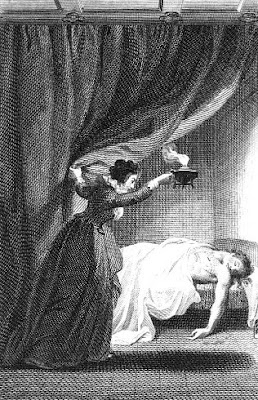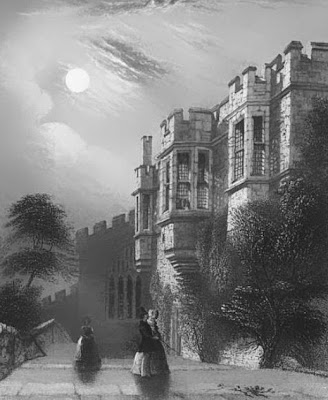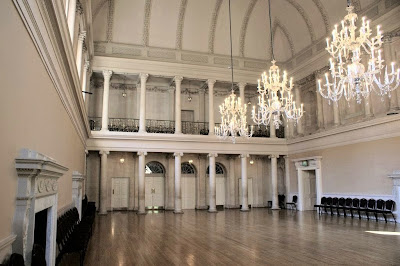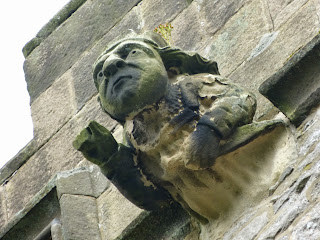 |
| Illustration from The Mysteries of Udolpho (1806 edition) |
The connection between Northanger Abbey and The Mysteries of Udolpho
The Mysteries of Udolpho by Mrs Ann Radcliffe was published in 1794 and became one of the most popular Gothic novels of its time. I have written a plot summary of the book in another post. The Mysteries of Udolpho has a special attraction to any fan of Jane Austen as it is referred to numerous times in Northanger Abbey. In her novel, Jane Austen delights in poking fun at the Gothic style and emphasising the ridiculousness of confusing fantasy with reality.
An unhealthy obsession
Read more about the Bath Assembly Rooms in the novels of Jane Austen here.
Catherine likes to make comparisons between the world of fantasy she is reading about in Udolpho and the reality of her daily life:
‘The mouth of the fool gushes folly’2
Jane Austen draws a stark comparison between Mr Thorpe, who makes bold statements without thought or understanding, and Mr Tilney, who speaks from an informed mind. Mr Thorpe claims never to read novels, but then promptly talks of the ones he has read. He claims to like Mrs Radcliffe’s novels and yet muddles up The Mysteries of Udolpho with Fanny Burney’s Camilla.
‘The person ... who has not pleasure in a good novel, must be intolerably stupid’
Jane Austen must have felt that gentlemen looked down on novels and so I am sure that it was no coincidence that she put her oft-quoted words in defence of the novel into the words of a gentleman, Northanger Abbey's hero, Mr Tilney:
The dangers of Gothic novels
In Catherine’s mind, Northanger Abbey becomes the Castle of Udolpho, where anything might have happened in the past. Her imagination runs away with her and she incurs Mr Tilney’s anger at her wild suppositions. This allows Jane Austen to defend her own style of writing – true pictures of character rather than the stylised players in a Gothic world that in no way resembled reality.
 |
| Haddon Hall from Evenings at Haddon Hall edited by Baroness EC de Calabrella (1846) (5) |
What is behind the black veil?
Catherine Morland, the heroine of Northanger Abbey, is painted as a very ordinary girl, with a very ordinary life, who has read rather a large number of novels. She becomes totally engrossed in The Mysteries of Udolpho and eagerly discusses it with her friend, Isabella Thorpe:
Catherine Morland, the heroine of Northanger Abbey, is painted as a very ordinary girl, with a very ordinary life, who has read rather a large number of novels. She becomes totally engrossed in The Mysteries of Udolpho and eagerly discusses it with her friend, Isabella Thorpe:
‘But, my dearest Catherine, what have you been doing with yourself all this morning? Have you gone on with Udolpho?’‘Yes, I have been reading it ever since I woke; and I am got to the black veil.’‘Are you, indeed? How delightful! Oh! I would not tell you what is behind the black veil for the world! Are you not wild to know?’‘Oh! Yes, quite; what can it be? – But do not tell me – I would not be told upon any account. I know it must be a skeleton, I am sure it is Laurentina’s skeleton. Oh! I am delighted with the book! I should like to spend my whole life in reading it, I assure you; if it had not been to meet you, I would not have come away from it for all the world.’1
There are times when the book grips Catherine’s imagination so much that it seems more exciting than reality:
If you want to find out what was behind the black veil, scan to the end of my plot summary of The Mysteries of Udolpho.‘I do not pretend to say that I was not very much pleased with him; but while I have Udolpho to read, I feel as if nobody could make me miserable. Oh! the dreadful black veil! My dear Isabella, I am sure there must be Laurentina’s skeleton behind it.’1
An unhealthy obsession
Later Jane laughs again at Catherine’s complete obsession with the book she is reading and states:
In spite of Udolpho and the dressmaker, however, the party from Pulteney-street reached the upper rooms in very good time.1
 |
| The tea room, the Assembly Rooms, Bath. They were known as the Upper Rooms to distinguish them from the older Lower Rooms |
Catherine likes to make comparisons between the world of fantasy she is reading about in Udolpho and the reality of her daily life:
‘Oh, that we had such weather here as they had at Udolpho, or at least in Tuscany and the South of France! – the night that poor St Aubin died! – such beautiful weather!’1
Blaise Castle
The proposed outing to Blaise Castle3 is particularly attractive to Catherine because she envisages something like Haddon Hall5 - a Gothic edifice akin to the Castle of Udolpho:
To feel herself slighted by them was very painful. On the other hand, the delight of exploring an edifice like Udolpho, as her fancy represented Blaize Castle to be, was such a counterpoise of good, as might console her for almost any thing.1
But Jane Austen is actually playing a joke on poor Catherine, because Blaise Castle was not a ruin or even that old. She was referring to a Gothic folly built in 1766 as a summer house to entertain the guests of its then owner, Thomas Farr!4
 |
| On the wall at Haddon Hall |
Jane Austen draws a stark comparison between Mr Thorpe, who makes bold statements without thought or understanding, and Mr Tilney, who speaks from an informed mind. Mr Thorpe claims never to read novels, but then promptly talks of the ones he has read. He claims to like Mrs Radcliffe’s novels and yet muddles up The Mysteries of Udolpho with Fanny Burney’s Camilla.
‘Have you ever read Udolpho, Mr Thorpe?’
‘Udolpho! Oh, Lord! Not I; I never read novels; I have something else to do.’
Catherine, humbled and ashamed, was going to apologise for her question; but he prevented her by saying, ‘Novels are all so full of nonsense and stuff; there has not been a tolerably decent one come out since Tom Jones, except the Monk; I read that t’other day; but as for all the others, they are the stupidest things in creation.’
‘I think you must like Udolpho, if you were to read it; it is so very interesting.’
‘Not I, faith! No, if I read any, it shall be Mrs Radcliffe’s; her novels are amusing enough; they are worth reading; some fun and nature in them.’
‘Udolpho was written by Mrs Radcliffe,’ said Catherine, with some hesitation, from the fear of mortifying him.
‘No, sure; was it? Ay, I remember, so it was; I was thinking of that other stupid book, written by that woman they made such a fuss about, she who married the French emigrant.’
‘I suppose you mean Camilla?’
‘Yes, that’s the book; such unnatural stuff!’1
 |
| Haddon Hall - possibly the inspiration for the Castle of Udolpho (5) |
Jane Austen must have felt that gentlemen looked down on novels and so I am sure that it was no coincidence that she put her oft-quoted words in defence of the novel into the words of a gentleman, Northanger Abbey's hero, Mr Tilney:
‘You have been abroad, then?’ said Henry, a little surprised.‘Oh no, I only mean what I have read about. It always puts me in mind of the country that Emily and her father travelled through, in The Mysteries of Udolpho. But you never read novels, I dare say?’‘Why not?’‘Because they are not clever enough for you – gentlemen read better books.’‘The person, be it gentleman or lady, who has not pleasure in a good novel, must be intolerably stupid. I have read all Mrs Radcliffe’s works, and most of them with great pleasure. The Mysteries of Udolpho, when I had once begun it, I could not lay down again; - I remember finishing it in two days – my hair standing on end the whole time.’‘I am very glad to hear it, indeed; and now I shall never be ashamed of liking Udolpho myself. But I really thought before, young men despised novels amazingly.’1
The ‘nicest’ book
We can catch a glimpse of how fashionable it was to enjoy Gothic romances by Catherine’s innocent comment that she found it the ‘nicest’ book. I think we can assume that Jane Austen disliked the word nice as being too generic!
We can catch a glimpse of how fashionable it was to enjoy Gothic romances by Catherine’s innocent comment that she found it the ‘nicest’ book. I think we can assume that Jane Austen disliked the word nice as being too generic!
‘But now, really, do not you think Udolpho the nicest book in the world?’‘The nicest; - by which I suppose you mean the neatest. That must depend upon the binding.’‘Come, Miss Morland, let us leave him to meditate over our faults in the utmost propriety of diction, while we praise Udolpho in whatever terms we like best. It is a most interesting work.’1
 |
| Illustration from The Mysteries of Udolpho (1806 edition) |
In Catherine’s mind, Northanger Abbey becomes the Castle of Udolpho, where anything might have happened in the past. Her imagination runs away with her and she incurs Mr Tilney’s anger at her wild suppositions. This allows Jane Austen to defend her own style of writing – true pictures of character rather than the stylised players in a Gothic world that in no way resembled reality.
Charming as were all Mrs Radcliffe’s works and charming even as were the works of all her imitators, it was not in them perhaps that human nature, at least in the midland counties of England, was to be looked for.
But in the central part of England there was surely some security for the existence even of a wife not beloved, in the laws of the land, and the manners of the age. Murder was not tolerated, servants were not slaves, and neither poison nor sleeping potions to be procured, like rhubarb, from every druggist.1
Rachel Knowles writes clean/Christian Regency era romance and historical non-fiction. She has been sharing her research on this blog since 2011. Rachel lives in the beautiful Georgian seaside town of Weymouth, Dorset, on the south coast of England, with her husband, Andrew.
Find out more about Rachel's books and sign up for her newsletter here.If you have enjoyed this blog and want to encourage me and help me to keep making my research freely available, please buy me a virtual cup of coffee by clicking the button below.
Notes
(1) From Northanger Abbey by Jane Austen (1818).
(2) From Proverbs 15v2 – I thought this verse summed up Mr Thorpe’s speech beautifully!
(3) Spelt Blaize by Jane Austen.
(4) Blaise Castle House was built in 1796-8 - around the time Jane Austen wrote Northanger Abbey - but the folly is almost 40 years older, dating from the time when Thomas Farr was using the estate as a private pleasure ground. For more details see the Friends of Blaise Castle website below.
(5) According to W Adam, in the Description of Buxton etc included below: Haddon Hall was ‘a structure which assisted the imagination of Mrs Radcliffe in its wildest flights, when writing The Mysteries of Udolpho.’
Sources used include:
(1) From Northanger Abbey by Jane Austen (1818).
(2) From Proverbs 15v2 – I thought this verse summed up Mr Thorpe’s speech beautifully!
(3) Spelt Blaize by Jane Austen.
(4) Blaise Castle House was built in 1796-8 - around the time Jane Austen wrote Northanger Abbey - but the folly is almost 40 years older, dating from the time when Thomas Farr was using the estate as a private pleasure ground. For more details see the Friends of Blaise Castle website below.
(5) According to W Adam, in the Description of Buxton etc included below: Haddon Hall was ‘a structure which assisted the imagination of Mrs Radcliffe in its wildest flights, when writing The Mysteries of Udolpho.’
Sources used include:
Adam, W, Description of Buxton, Chatsworth, Bakewell, Haddon Hall, and Castleton: with a tabular view of the principal drives and objects of interest throughout the county: abridged from Adam's Gem of the Peak (1852)
Austen, Jane, Northanger Abbey (1818)
Calabrella, Baroness EC de (editor), Evenings at Haddon Hall (1846)
Radcliffe, Mrs Ann, The Mysteries of Udlopho (1794)
Austen, Jane, Northanger Abbey (1818)
Calabrella, Baroness EC de (editor), Evenings at Haddon Hall (1846)
Radcliffe, Mrs Ann, The Mysteries of Udlopho (1794)
Blaise Castle House Museum website
Friends of Blaise Castle website - not currently working (17/10/19)
Photographs © Andrew Knowles
Friends of Blaise Castle website - not currently working (17/10/19)
Photographs © Andrew Knowles

